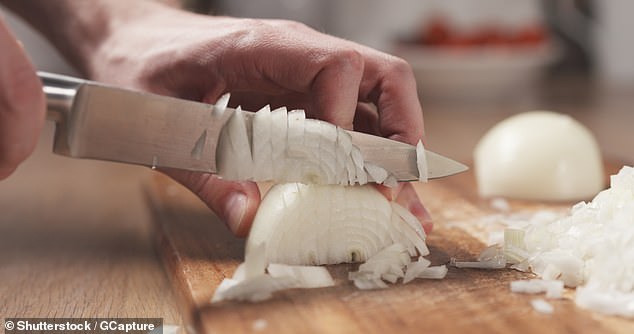Whether you’re a pro chef or a cookery novice, chopping an onion is one of the first things you learn to do in the kitchen.
But, according to mathematicians, you may have been chopping onions wrong this whole time.
Experts say you should be making your cuts according to a rule known as the ‘onion constant’.
Using this mathematically proven technique will give you more evenly cut pieces for optimal onion cooking.
Dicing an onion traditionally involves slicing the vegetable in half before making a series of vertical cuts.
However, this runs the risk of creating extremely inconsistent pieces which will cook at different speeds.
And making a few horizontal cuts before you start will always make those pieces even less consistent.
So, here’s how you can dice an onion perfectly every time.

Chopping onions might seem simple, but according to mathematicians you have been doing it wrong all along (stock image)
If you cut into an onion with distinct layers, the way those layers curve means that all the pieces will never all be the exact same size.
So if you cut into an onion using perfectly vertical cuts, the pieces near the middle will be very even, but the pieces towards the edges will be much larger.
You might try to fix this by making your cuts ‘radially’, that is, angled to meet at the centre of the onion.
But this will make the pieces from the core much smaller than those at the edge, leading to an even less consistent dice.
As it turns out, there is a very specific angle at which you need to aim your cuts if you want to make the pieces of onion as consistent as possible.
Dr Dylan Poulsen, an associate professor of mathematics at Washington College, calculated in a blog post that you need to make your cuts while aiming at an imagined centre point below your chopping board.
Dr Poulsen told Daily Mail: ‘Using calculus, I found that to minimise the variance of the area of the onion pieces, a chef should aim at a point under the centre of the onion that is 0.55730669298566447885… onion radiuses beneath the centre of the half-onion.’
In simpler terms, imagine there is a point below your chopping board, roughly half as far down as the onion is tall.

Rather than making your cuts vertically, you should aim the knife at a point below the centre of the onion. Mathematician Dr Dylan Poulson calls this depth ‘the onion constant’
If you try to hit that point with your cuts, rather than aiming at the centre of the onion, the resulting pieces will be more even.
However, as Dr Poulson points out, this ideal number is based on the ‘unrealistic case of infinitely many layers and infinitely many cuts.’
In the real world, onions typically have between seven and 13 layers, and you aren’t likely to make more than 10 cuts.
According to calculations made by Andrew Aquino for The Pudding, the perfect dice angle for making 10 cuts in a 10-layer onion is aimed at a point 96 per cent of the onion’s radius below the cutting surface.
Imagine that the onion were still whole and try to aim your cuts so that they would meet at roughly the same point on the opposite side.
Practically, that means holding your knife fairly close to vertical but tilting it slightly towards the cutting surface as you work your way to either side.
The exact angle varies depending on the number of cuts and layers, and the mathematics to find those points starts to get very complex.
However, the ideal depth to aim for is always more than 48 per cent of the onion’s radius below the board.

For an onion with 10 layers, you should aim at a point 96 per cent of the onion’s radius below the board. In practice that means your cuts will be close to horizontal nearer the middle, and slightly angled towards the board on either side
Read More
Revealed: What the smell of your BODY ODOUR says about you, according to science

Interestingly, these calculations also show that adding any number of horizontal cuts before you start chopping will only make the pieces less consistent.
That means you never need to waste time making fiddly cuts instead of simply chopping.
While this puzzle might have started as nothing more than a mathematical curiosity, Dr Poulson says he now uses this technique to cut his onions perfectly.
He says: ‘I don’t believe there is any great difference to the quality of the food, but I do get a sense of mathematical joy cutting onions this way.’
